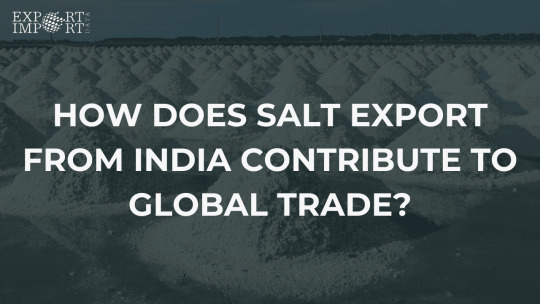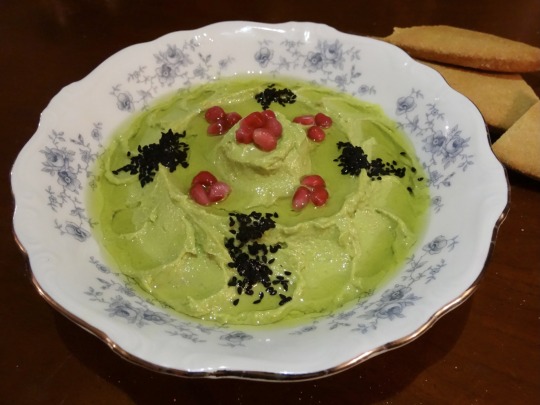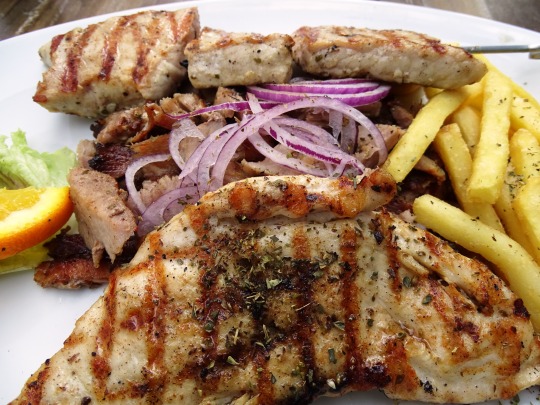#Salt export data
Explore tagged Tumblr posts
Text
Discover India's booming salt export from India industry with Eximpedia. Get the latest salt export data, HSN codes, top exporters, and key global buyers in one place.
#salt export from india#salt export data#salt hsn code#salt exporters in india#salt export data from india
0 notes
Text
How Does Salt Export from India Contribute to Global Trade?

India is one of the largest producers and exporters of salt in the world, supplying various types of salt to international markets. But how exactly does salt export from India work, and what are the key factors influencing this trade? In this article, we will explore salt export data, Salt HSN Code, major salt exporters in India, and the leading salt export countries. Let’s dive into some of the most frequently asked questions about India’s salt export industry.
1. Why is India a Major Player in Salt Export?
India has a long coastline, particularly in Gujarat, Tamil Nadu, and Rajasthan, which provides ideal conditions for salt production. The country’s salt industry benefits from:
Favorable Climate – Hot temperatures aid in the natural evaporation process.
Large Production Capacity – India produces over 30 million metric tons of salt annually.
Cost-Effective Production – The availability of cheap labor and land reduces production costs.
Global Demand – Countries around the world require salt for industrial, food, and medicinal purposes.
India’s ability to meet international demand efficiently makes it a key player in global salt trade.
2. What is the Latest Salt Export Data from India?
India exports millions of tons of salt every year to various countries. The latest salt export data highlights:
Total Export Volume – India exports over 4-6 million metric tons of salt annually.
Major Importers – Key salt export countries include China, Indonesia, South Korea, and Bangladesh.
Export Value – The annual revenue from export of salt from India is estimated to be over $300 million.
Growth Trends – The demand for Indian salt, especially Himalayan salt, has been increasing.
The export data reflects India’s strong presence in the global salt market.
3. What is the HSN Code for Salt Export?
The Salt HSN Code (Harmonized System of Nomenclature) is used for the classification of salt in international trade. The HSN codes for different types of salt include:
HSN Code 2501 – Covers all types of salt, including table salt, industrial salt, and rock salt.
HSN Code 25010010 – For refined salt or table salt.
HSN Code 25010020 – For unprocessed salt.
HSN Code 25010030 – For Himalayan salt and other mineral-rich salts.
These codes help streamline the export documentation process.
4. Which Countries Import the Most Salt from India?
India exports salt to several countries across Asia, Africa, and the Middle East. The top salt export countries include:
China – The largest importer of Indian salt for industrial and food processing purposes.
Indonesia – Uses Indian salt in chemical and food industries.
South Korea – Imports refined salt for food production.
Bangladesh – A major consumer of Indian salt due to its geographic proximity.
Vietnam, Japan, and UAE – These nations also rely on India for salt imports.
The demand from these countries continues to grow due to India’s consistent quality and supply.
5. What is the Role of Himalayan Salt in India’s Salt Export?
Himalayan salt export data indicates a significant rise in the demand for this pink mineral-rich salt. Key factors include:
Health Benefits – Rich in minerals like potassium, magnesium, and iron.
Global Trend – Increasing popularity in the wellness and organic food industries.
Major Markets – The USA, UK, Germany, and Australia import large quantities of Himalayan salt from India.
Varied Applications – Used in cooking, bath salts, and spa treatments.
India’s growing role in the Himalayan salt market has further boosted its position in global salt exports.
6. Who are the Leading Salt Exporters in India?
Several companies contribute to India's strong position in salt exports. Some of the major salt exporters in India include:
Tata Chemicals – One of the biggest players in the Indian salt industry.
Gujarat Heavy Chemicals Ltd. (GHCL) – Specializes in industrial and food-grade salt exports.
Amit Salt – A leading exporter of Himalayan pink salt.
Nirma Limited – Supplies industrial and refined salt globally.
Hindustan Salts Ltd. – A government-backed company exporting various salt types.
These exporters ensure that Indian salt reaches markets worldwide efficiently.
7. What Challenges Does India Face in Salt Export?
Despite being a major salt exporter, India faces some challenges in salt exports, such as:
Fluctuating Global Prices – Changes in demand and production costs impact profitability.
Weather Dependency – Heavy rains and unexpected climate changes can reduce production.
Regulatory Hurdles – Export regulations, tariffs, and documentation requirements can slow down shipments.
Competition – Countries like China and Australia also export large quantities of salt.
To maintain its stronghold, India needs to address these challenges effectively.
8. How Can India Expand Its Salt Export Market?
To further enhance its position in the global salt market, India can take the following steps:
Improving Infrastructure – Better storage and transportation facilities to reduce wastage.
Exploring New Markets – Expanding exports to Europe and the Americas.
Quality Control Measures – Ensuring consistency in salt purity and standards.
Value-Added Products – Offering flavored, iodized, and specialty salts to attract niche markets.
With these strategies, India can boost its salt exports and remain competitive.
Conclusion
India plays a crucial role in the global salt trade, with salt export from India reaching millions of tons annually. The salt export data shows a steady demand from countries like China, Indonesia, and Bangladesh. With the right strategies, India can further enhance its salt exports, especially Himalayan salt, and maintain its competitive edge.
FAQs
1. Which country is the largest importer of Indian salt?
China is the largest importer of Indian salt, followed by Indonesia, Bangladesh, and South Korea.
2. What is the Salt HSN Code used for export?
The main Salt HSN Code is 2501, with specific subcategories like 25010010 for refined salt and 25010030 for Himalayan salt.
3. How much salt does India export annually?
India exports around 4-6 million metric tons of salt each year, generating significant revenue.
4. Why is Himalayan salt in high demand?
Himalayan salt is rich in minerals and widely used in health and wellness industries, driving its global demand.
5. What are the major challenges in salt export from India?
Weather dependency, fluctuating prices, regulatory issues, and global competition are key challenges faced by Indian salt exporters.
By leveraging its natural resources and strategic exports, India continues to dominate the global salt trade. With ongoing improvements in production and quality, its presence in the international market is set to grow even further.
#Salt export from India#Salt export data#Salt HSN Code#himalayan salt export data#export of salt from India#salt exporters#salt exporters in india#salt export countries
0 notes
Text
India is one of the world’s largest salt producers and exporters, dominating global markets with millions of tons shipped annually. Explore India’s salt production, top export countries, key HSN codes, salt export from India and leading exporters in this comprehensive guide to India’s thriving salt trade.
#Salt export from India#Salt export data#Salt HSN Code#salt exporters in india#salt export countries#salt export data from India
0 notes
Text

India is the world's largest salt exporter, shipping 13.73 billion kg in 2023. Major destinations include China, Korea, and Japan. Key exporters include Krishna Salt and Ahir Salt Industries. Learn more about salt HSN codes, salt export data from India, and market trends at Seair Exim Solutions.
#Salt export from India#Salt export data#Salt HSN Code#export of salt from India#export salt from India#salt exporters in india#salt export countries#salt export data from India
0 notes
Text
#pakistan salt export data#pakistan custom import data#import data pakistan#pak trade info#paktradeinfo#pakistan customs import data#pakistan customs data#import export data pakistan#exim trade info#custom data pakistan#import data of pakistan#import export data#pak exim trade info#import and export of pakistan
0 notes
Text

[ID: A bowl of avocado spread sculpted into a pattern, topped with olive oil and garnished with symmetrical lines of nigella seeds and piles of pomegranate seeds; a pile of pita bread is in the background. End ID]
متبل الأفوكادو / Mutabbal al-'afukadu (Palestinian avocado dip)
Avocados are not native to Palestine. Israeli settlers planted them in Gaza in the 1980s, before being evicted when Israel evacuated all its settlements in Gaza in 2005. The avocados, however, remained, and Gazans continued to cultivate them for their fall and winter harvest. Avocados have been folded into the repertoire of a "new" Palestinian cuisine, as Gazans and other Palestinians have found ways to interpret them.
Palestinians may add local ingredients to dishes traditionally featuring avocado (such as Palestinian guacamole, "جواكامولي فلسطيني" or "غواكامولي فلسطيني"), or use avocado in Palestinian dishes that typically use other vegetables (pickling them, for example, or adding them to salads alongside tomato and cucumber).
Another dish in this latter category is حمص الافوكادو (hummus al-'afukadu)—avocado hummus—in which avocado is smoothly blended with lemon juice, white tahina (طحينة البيضاء, tahina al-bayda'), salt, and olive oil. Yet another is متبّل الأفوكادو (mutabbal al-'afukadu). Mutabbal is a spiced version of بابا غنوج (baba ghannouj): "مُتَبَّل" means "spiced" or "seasoned," from "مُ" "mu-," a participlizing prefix, + "تَبَّلَ" "tabbala," "to have spices added to." Here, fresh avocado replaces the roasted eggplant usually used to make this smooth dip; it is mixed with green chili pepper, lemon juice, garlic, white tahina, sumac, and labna (لبنة) or yoghurt. Either of these dishes may be topped with sesame or nigella seeds, pomegranate seeds, fresh dill, or chopped nuts, and eaten with sliced and toasted flatbread.
Avocados' history in Palestine precedes their introduction to Gaza. They were originally planted in 1908 by a French order of monks, but these trees have not survived. It was after the Balfour Declaration of 1917 (in which Britain, having been promised colonial control of Palestine with the dissolution of the Ottoman Empire after World War 1, pledged to establish "a national home for the Jewish people" in Palestine) that avocado agriculture began to take root.
In the 1920s, 30s, and 40s, encouraged by Britain, Jewish Europeans began to immigrate to Palestine in greater numbers and establish agricultural settlements (leaving an estimated 29.4% of peasant farming families without land by 1929). Seeds and seedlings from several varieties of avocado were introduced from California by private companies, research stations, and governmental bodies (including Mikveh Israel, a school which provided settlers with agricultural training). In these years, prices were too high for Palestinian buyers, and quantities were too low for export.
It wasn't until after the beginning of the Nakba (the ethnic cleansing of Palestinians from "Jewish" areas following the UN partition of Palestine in 1947) that avocado plantings became significant. With Palestinians having been violently expelled from most of the area's arable land, settlers were free to plant avocados en masse for export, aided (until 1960) by long-term, low-interest loans from the Israeli government. The 400 acres planted within Israel's claimed borders in 1955 ballooned to 2,000 acres in 1965, then 9,000 by 1975, and over 17,000 by 1997. By 1986, Israel was producing enough avocados to want to renegotiate trade agreements with Europe in light of the increase.
Israeli companies also attained commercial success selling avocados planted on settlements within the West Bank. As of 2014, an estimated 4.5% of Israeli avocado exports were grown in the occupied Jordan Valley alone (though data about crops grown in illegal settlements is of course difficult to obtain). These crops were often tended by Palestinian workers, including children, in inhumane conditions and at starvation wages. Despite a European Union order to specify the origin of such produce as "territories occupied by Israel since 1967," it is often simply marked "Israel." Several grocery stores across Europe, including Carrefour, Lidl, Dunnes Stores, and Aldi, even falsified provenance information on avocados and other fruits in order to circumvent consumer boycotts of goods produced in Israel altogether—claiming, for example, that they were from Morocco or Cyprus.
Meanwhile, while expanding its own production of avocados, Israel was directing, limiting, and destabilizing Palestinian agriculture in an attempt to eliminate competition. In 1982, Israel prohibited the planting of fruit trees without first obtaining permission from military authorities; in practice, this resulted in Palestinians (in Gaza and the West Bank) being entirely barred from planting new mango and avocado trees, even to replace old, unproductive ones.
Conditions worsened in the years following the second intifada. Between September of 2000 and September of 2003, Israeli military forces destroyed wells, pumps, and an estimated 85% of the agricultural land in al-Sayafa, northern Gaza, where farmers had been using irrigation systems and greenhouses to grow fruits including citrus, apricots, and avocados. They barred almost all travel into and out of al-Sayafa: blocking off all roads that lead to the area, building barricades topped with barbed wire, preventing entry within 150 meters of the barricade under threat of gunfire, and opening crossings only at limited times of day and only for specific people, if at all.
A July 2001 prohibition on Palestinian vehicles within al-Sayafa further slashed agricultural production, forcing farmers to rely on donkeys and hand carts to tend their fields and to transport produce across the crossing. If the crossing happened to be closed, or the carts could not transport all the produce in time, fruits and vegetables would sit waiting in the sun until they rotted and could not be sold. The 2007 blockade worsened Gaza's economy still further, strictly limiting imports and prohibiting exports entirely (though later on, there would be exceptions made for small quantities of specific crops).
In the following years, Israel allowed imports of food items into Gaza not exceeding the bare minimum for basic sustenance, based on an estimation of the caloric needs of its inhabitants. Permitted (apples, bananas, persimmons, flour) and banned items for import (avocados, dates, grapes) were ostensibly based on "necessary" versus "luxury" foods, but were in fact directed according to where Israeli farmers could expect the most profit.
Though most of the imports admitted into Gaza continued to come from Israel, Gazan farmers kept pursuing self-sufficiency. In 2011, farmers working on a Hamas-government-led project in the former settlements produced avocados, mangoes, and most of the grapes, onions, and melons that Gazans ate; by 2015, though still forbidden from exporting excess, they were self-sufficient in the production of crops including onions, watermelon, cantaloupe, grapes, almonds, olives, and apples.
Support Palestinian resistance by calling Elbit System’s (Israel’s primary weapons manufacturer) landlord, donating to Palestine Action’s bail fund, and donating to the Bay Area Anti-Repression Committee bail fund.
Ingredients:
2 medium avocados (300g total)
1/4 cup white tahina
2 Tbsp labna (لبنة), or yoghurt (laban, لبن رايب)
1 green chili pepper
2 cloves garlic
2 Tbsp good olive oil
Juice of 1/2 lemon (1 1/2 Tbsp)
1 tsp table salt, or to taste
Pomegranate seeds, slivered almonds, pine nuts, chopped dill, nigella seeds, sesame seeds, sumac, and/or olive oil, to serve
Khubiz al-kmaj (pita bread), to serve
Instructions:
1. In a mortar and pestle, crush garlic, pepper, and a bit of salt into a fine paste.
2. Add avocados and mash to desired texture. Stir in tahina, labna, olive oil, lemon juice, and additional salt.
You can also combine all ingredients in a blender or food processor.
3. Top with a generous drizzle of olive oil. Add toppings, as desired.
4. Cut pita into small rectangles or triangles and separate one half from the other (along where the pocket is). Toast in the oven, or in a large, dry skillet, stirring occasionally, until golden brown. Serve dip alongside toasted pita chips.

489 notes
·
View notes
Text
Driven by pre-salt, oil becomes Brazil's top export

Oil closed 2024 as Brazil's leading export, surpassing soybeans. Crude oil and mineral oil exports totaled $44.8 billion, according to data released last week by the Foreign Trade Secretariat of the Ministry of Development, Industry, Trade, and Services.
Crude oil is primarily composed of hydrocarbons, which account for 98 percent of its total composition. Minor constituents include sulfur, nitrogen, and oxygen, while trace amounts of metals such as vanadium, nickel, sodium, calcium, copper, and uranium are also present.
Brazil's top export in 2024 was crude oil, accounting for 13.3 percent of the country's total exports. It overtook soybeans, which saw their share drop by 3 percentage points, from 15.7 percent in 2023 to 12.7 percent in 2024. Soybean exports generated $42.9 billion in 2024, down from $53.2 billion in the previous year.
Oil extracted from the pre-salt layer was the key factor behind oil's rise to the top of Brazil's export list. According to Brazil��s National Agency of Petroleum, Natural Gas, and Biofuels (ANP), the country produced an average of 36.9 million barrels of oil per day from January to November—the latest available data—with 71.5 percent of this output coming from the pre-salt layer. In the second half of the year, this share increased to 80.3 percent.
Continue reading.
3 notes
·
View notes
Text

















National Onion Day
Today, farmers in the United States are collecting millions of onions. They will be heading for store shelves to provide families with the fresh, nutritional, tasty power to improve meals and boost the body’s immunity. Onions have numerous advantages, such as enhancing meals with a variety of flavors. According to recent research, consuming onions also helps the body fight colorectal cancer and breast cancer, as well as heart disease and diabetes.
National Onion Day commemorates the incorporation of the National Onion Association in 1913. The organization was created to protect the interests of America’s onion growers, and onions remain their business to this day. Today, the group represents over 500 onion producers, shippers, packers, and suppliers across the country.
History of National Onion Day
In June 2022, the National Onion Association established National Onion Day to commemorate the organization’s 53rd anniversary. They officially incorporated on June 27, 1913, in Ohio, and represent almost 500 onion farmers, shippers, packers, and allied members across the U.S.
Onions are one of the world’s oldest cultivated vegetables, having originated in Central Asia and spread around the world. Some researchers believe the onion has been cultivated for at least 5,000 years. Onions were possibly eaten for thousands of years and cultivated all over the world at the same time, since they grew wild in different locations.
We rely on the onion to improve the flavor of our savory meals, whether we use a sweet, white, red, or ever-popular yellow onion. They complement meats and salads, making the versatile onion a culinary powerhouse. It’s the needed seasoning alongside our salt and pepper, whether added to eggs or pickled. While the onion is low in calories, it is also high in vitamin C and antioxidants, and can increase your dietary fiber and vitamin B6 intake. Unlike many other low-calorie ingredients, onions provide a high nutritional content without compromising flavor. And it makes no difference what you do to it; pickled or raw, caramelized, sauteed, or pureed — the onion adds a lot of flavor to a dish. With so many types to choose from, onions present numerous opportunities to reap the benefits.
National Onion Day timeline
3500 B.C. The Onion is First Traced in Egypt
The history of the onion can be traced back to this period, with a Sumerian document describing someone being in awe of the city governor’s onion garden.
1500 B.C. Ancient Egypt Worships Onions
To those who bury onions alongside their pharaohs, onions are a sign of eternity.
1913 National Onion Association Is Founded
On June 2, the National Onion Association is formally incorporated in Ohio.
2019 National Onion Day is First Celebrated
The National Onion Association establishes National Onion Day on June 27, to honor onion producers.
National Onion Day FAQs
Is an onion a vegetable or a fruit?
The vegetables are classified based on the edible part of the plant: leaves (like lettuce), roots (like carrot), bulbs (such as onions), and many others. Alternatively, fruits such as tomatoes and seeds such as peas are commonly referred to as vegetables.
Which country is the largest onion exporter?
According to FY18 data, China appears to be the top onion producer, but the Netherlands is the largest onion exporter.
Do onions aid in the treatment of infections?
Onions were worshiped for their medicinal powers by various civilizations. They have anti-inflammatory properties, relieve joint pain, treat ear infections, work as an antibiotic, and are an excellent expectorant for loosening up thick phlegm.
National Onion Day Activities
Add fresh onion to your favorite recipe
Learn how to grow onions in your backyard
Share the celebration on social media
For a flavor boost, be sure to add some onion in there. No matter how you slice it, onion pulls together some of the greatest flavors! Tell us how you like to cook your onions!
Gardening is fun! Furthermore, if you can cultivate some veggies like onions in your backyard, you can reduce the cost of your monthly groceries by harvesting them yourself.
Be sure to spread the word about National Onion Day by using the hashtag #NationalOnionDay on social media. Also, don’t forget to brag about your onion recipe or how you harvested your own onions.
5 Interesting Facts About Onion
They’ve been around for thousands of years
Sulfuric acid
Onions were worshiped by Ancient Egyptians
The biggest onion ever
The Big Onion
Onions have been present for thousands of years and, around 3,500 B.C, onions were harvested for the first time.
The reason you become teary-eyed when cutting onions is because of the sulfuric acid they contain.
They claimed that the spherical shape and concentric circles represented eternity — onions were used to cover the tombs of their monarchs and were important in ritual burials.
According to ‘The Guinness Book of World Records’, the biggest onion ever was cultivated by Peter Glazebrook, a British farmer, who grew a massive onion in 2011 that weighed just under 18 pounds.
Before it was known as the Big Apple, New York was known as the Big Onion, because it was a place where you could peel layer after layer without touching the center, kind of like an onion.
Why We Love National Onion Day
It encourages cultivation
It promotes culinary creativity
It boosts the immune system
Onions are an important, and healthy part of our diet. Why not grow and cultivate your own in your backyard?
Who would have thought onions, known for making us cry, could be so sweet and delectable with some creativity? These days, almost all culinary innovations use onion for a unique flavor.
Onions are rich in prebiotics. This helps to increase friendly bacteria in your guy, which helps to build immunity against viruses.
Source
#vacation#Jaime-Style with cheese & sauce Burrito#USA#food#Chow Line#Cowboy Burger#Chili Burger#Texas Roadhouse Chili#steak with mushrooms#Onion Rings#Pho Tai#Beef Black Pepper#Crispy Rice Noodle Tower#Pavla Plate#Green Chile Burger#National Onion Day#27 food#travel#original photography#restaurant#Canada#Fire Jumper Burger#Roast beef with remoulade & fried onions Smörrebröd#Greek Pizza
12 notes
·
View notes
Text
Quinine Sulphate: Trusted API for Malaria and Fever Relief
Malaria and fever-related illnesses continue to affect millions around the world, highlighting the need for dependable pharmaceutical treatments. One of the most trusted antimalarials is quinine sulphate, celebrated for its effectiveness and long history in healthcare. At Prism Industries Pvt. Ltd., we take pride in producing high-quality sulphate of quinine that adheres to global pharmacopoeial standards. With a strong emphasis on pharmaceutical API manufacturing, our dedication to quality, consistency, and therapeutic reliability has established us as a reliable supplier in both domestic and international markets.
Introduction to Quinine Sulphate
Quinine sulphate is a salt form of quinine, an alkaloid sourced from the bark of the cinchona tree. It has historically been one of the first effective treatments for malaria. Today, sulphate of quinine is still a vital part of treating resistant strains of Plasmodium falciparum, as well as managing nocturnal leg cramps and fever symptoms.
At Prism Industries Pvt. Ltd., our API-grade quinine sulphate is produced to guarantee high purity, safety, and bioavailability, serving pharmaceutical formulation companies around the globe.
The Role of Quinine Sulphate in Malaria Treatment
Quinine sulphate is a key player in the fight against malaria. It works by disrupting the parasite’s ability to break down hemoglobin, which ultimately leads to its demise within red blood cells. This medication is particularly valuable when other antimalarial treatments either don’t work or aren’t suitable for the patient.
You can find quinine sulphate in several forms, including:
- Oral tablets
- Injectable solutions
- Combination therapies that include antibiotics or antipyretics
Why Choose Quinine Sulphate API?
- It has a strong track record of effectiveness against malaria and related fever conditions.
- It acts quickly, especially in severe cases of malaria.
- It has a long history of safety, backed by decades of clinical use.
- It’s versatile enough for use in both human and veterinary medicine.
These advantages make quinine sulphate a reliable choice for healthcare professionals and pharmaceutical companies alike.
Prism Industries: A Trusted Leader in Pharma API Manufacturing
At Prism Industries Pvt. Ltd., we pride ourselves on our expertise in pharma API manufacturing, supported by cutting-edge technology, strict regulatory compliance, and a strong commitment to quality control. As a certified manufacturer, we adhere to GMP, ISO, and ICH guidelines, ensuring that our sulphate of quinine meets the highest international standards.
Key Manufacturing Highlights:
Purity exceeding 99.5%
Rigorous control of microbial and heavy metal content
Tailored packaging solutions for bulk orders and exports
Flexible production capacity to meet demand
Regulatory and Quality Assurance
Our quinine sulphate is accompanied by thorough regulatory documentation, which includes:
Certificate of Analysis (CoA)
MSDS (Material Safety Data Sheet)
GMP compliance certificate
DMF (Drug Master File) available upon request
This comprehensive documentation helps our clients navigate the registration process with health authorities in Europe, Asia, and the Americas.
Applications of Sulphate of Quinine
Treating uncomplicated and severe malaria
Managing fever, especially when it’s caused by parasites
Relieving muscle cramps, particularly those pesky nocturnal leg cramps
Using combination therapy to boost effectiveness and lower the risk of resistance
Our quinine sulphate is trusted by pharmaceutical companies, hospitals, and research organizations to create tablets, syrups, and injectables.
Custom Solutions in Pharma API Manufacturing
Recognizing that every formulation has its own unique needs, we provide tailored services such as:
Customized particle size distribution
Packaging designed for optimal stability
Documentation that meets formulation-grade standards
Our adaptability and scientific know-how make us a go-to partner for pharma API manufacturing.
Commitment to Sustainability and Safety
As a conscientious quinine sulphate manufacturer, we embrace:
Green chemistry practices
Systems for recovering solvents
Effluent treatment facilities
Lower carbon emissions through energy-efficient equipment
We are dedicated to aligning with global goals to produce APIs that are not just effective but also environmentally friendly.
Packaging and Export Readiness
We provide a variety of packaging options:
- 5 kg and 25 kg HDPE drums
- Vacuum-sealed aluminum pouches
- Secure, tamper-proof packaging designed for international shipping
Our logistics partners guarantee prompt delivery throughout Europe, Africa, Southeast Asia, and Latin America.
Why Choose Prism Industries for Quinine Sulphate?
1. Trusted Industry Expertise
With decades of experience in pharmaceutical API manufacturing, we specialize in antimalarial APIs.
2. Global Certifications
Our facilities are GMP, WHO-GMP, and ISO certified, offering comprehensive regulatory support.
3. End-to-End Client Support
From your initial inquiry to documentation and post-sale assistance, our technical and export teams are here to ensure everything goes smoothly.
4. Innovation and R&D Focus
We’re committed to ongoing research aimed at improving the purity, stability, and formulation adaptability of sulphate of quinine.
Future Outlook
The need for effective antimalarial agents, such as quinine sulphate, is still very much alive, particularly in areas where malaria is prevalent. At Prism Industries, we're making significant investments in cutting-edge purification methods and collaborative research and development to create next-generation formulations and investigate new therapeutic uses for sulphate of quinine.
Global Reach
We take pride in supplying our quinine sulphate to more than 40 countries, including:
- Nigeria
- Kenya
- South Africa
- Vietnam
- Myanmar
- Brazil
- Colombia
- Egypt
Our expanding network showcases our reliability and the high quality of our products.
Conclusion
Quinine sulphate remains one of the trusted active pharmaceutical ingredients in the battle against malaria and fever-related illnesses. At Prism Industries Pvt. Ltd., our dedication to quality, compliance, and customer satisfaction has made us a preferred supplier of sulphate of quinine on a global scale. Through our advanced pharmaceutical API manufacturing, we provide solutions that enable pharmaceutical brands to develop effective, safe, and accessible treatments.
Choose Prism Industries Pvt. Ltd. – where tradition blends with innovation in the realm of antimalarial APIs.
0 notes
Text
Major Ports in India: Gateways of Global Trade

India's 7,500-kilometer coastline makes it a maritime giant linking the subcontinent to global markets. Its ports function as crucial trade channels handling over 90% of its international trade by volume and about 70% by value. The country's 13 major ports located along both eastern and western shores, play a key role in India's economic growth and its rising importance in world trade.
This post will give you a rundown of these major ports, look at what they export, point out why they matter , and zero in on one of the most talked-about new ports — the Vizhinjam International Seaport. This breakdown will be helpful for people keeping tabs on India's import-export numbers, or those working with companies that provide global import-export data.
Overview of Major Ports in India
India has 13 major ports, categorized under the central government, and over 200 minor and intermediate ports under state governance. The 13 major ports are:
Kandla (Deendayal Port), Gujarat
Mumbai Port, Maharashtra
Jawaharlal Nehru Port (JNPT), Maharashtra
Mormugao Port, Goa
New Mangalore Port, Karnataka
Cochin Port, Kerala
Chennai Port, Tamil Nadu
Ennore (Kamarajar) Port, Tamil Nadu
Vishakhapatnam Port, Andhra Pradesh
Paradip Port, Odisha
Haldia Port (part of Kolkata Port), West Bengal
Kolkata Port, West Bengal
Tuticorin (V.O. Chidambaranar) Port, Tamil Nadu
These ports play a central role in handling the import and export data of India, enabling everything from oil and coal to electronics and agricultural goods to reach global markets.
13 Major Ports: States and Export Highlights
PortStateMajor Export ProductsKandla (Deendayal)GujaratPetroleum products, salt, textilesMumbai PortMaharashtraChemicals, machinery, garmentsJNPT (Nhava Sheva)MaharashtraElectronics, auto parts, textilesMormugaoGoaIron ore, manganeseNew MangaloreKarnatakaCoffee, cashew, graniteCochinKeralaSeafood, spices, coir productsChennaiTamil NaduAutomobiles, leather, machineryEnnore (Kamarajar)Tamil NaduCoal, petroleum productsVishakhapatnamAndhra PradeshIron ore, alumina, seafoodParadipOdishaCoal, iron ore, fertilizerHaldiaWest BengalPetrochemicals, jute productsKolkataWest BengalTea, jute, leatherTuticorinTamil NaduSalt, garments, seafood
Each port specializes based on local industry clusters, making them strategic assets not only for local economies but for India’s position in global import export data rankings.
Port-wise Export Value and Country Connections
Understanding which countries India exports to via these ports adds valuable context for import export data analysts:
Kandla & JNPT handle large volumes to Middle Eastern nations, especially UAE and Saudi Arabia.
Chennai and Ennore see significant exports to ASEAN countries, such as Malaysia and Singapore.
Tuticorin and Cochin connect mainly with European and African nations, for spices and seafood.
Paradip and Vishakhapatnam are crucial for bulk exports to China, Japan, and South Korea, primarily raw materials.
Kolkata & Haldia facilitate trade with Bangladesh, Nepal, and East Asia, due to their eastern proximity.
Such port-wise segmentation is essential for businesses working with a global import export data provider to optimize supply chains and reduce logistical costs.
Vizhinjam International Seaport: A Strategic Leap Forward
What is Vizhinjam Port?
The Vizhinjam International Seaport is India’s first deep-water, all-weather container transshipment terminal, located near Thiruvananthapuram, Kerala. Developed by Adani Ports, the port is expected to be operational soon and will become a game-changer in South Asia’s maritime trade.
Key Features
Natural depth of over 20 meters: No need for extensive dredging.
Proximity to International Shipping Lanes: Just 10 nautical miles from the busiest East-West shipping route.
Modern transshipment capacity: Meant to rival ports like Colombo (Sri Lanka) and Singapore.
Benefits for India
Reduce Transshipment Dependency: India currently transships a large share of its cargo via foreign ports. Vizhinjam will reduce this dependency, cutting costs and time.
Enhance India’s Export Competitiveness: Especially for time-sensitive products like perishables and electronics.
Boost Domestic Manufacturing: Local industries in Kerala and Tamil Nadu will benefit from faster access to global markets.
Strengthen National Logistics Policy (NLP): Aligns with India's plan to cut logistics costs from 13% to 8% of GDP.
For stakeholders tracking India import export data, Vizhinjam represents a high-potential node of future trade activity, worth close attention in datasets and forecasting.
India's Port Strategy and the Role of Data
In today's world of agile supply chains and just-in-time delivery, import export data is no longer optional — it’s mission-critical. Understanding port performance, commodity flows, and country-wise trade splits can help businesses:
Anticipate demand trends
Optimize port selection
Identify growth opportunities
Leveraging a global import export data provider helps exporters and importers keep pace with competition, track compliance regulations, and manage international freight efficiently.
Conclusion
India's 13 major ports are not just logistical points — they are gateways to global commerce. From historical ports like Kolkata to emerging powerhouses like Vizhinjam, each plays a unique role in India's export-led growth. As India aspires to become a $5 trillion economy, these ports — backed by robust India import export data — will be central to achieving that goal.
Businesses that harness the insights of import export data, especially from a global import export data provider, will be better positioned to navigate uncertainties, scale operations, and enter new markets. Whether you're shipping spices from Cochin or electronics from JNPT, India’s ports are your bridge to the world.
#global import export data provider#import export data#Vizhinjam International Seaport#India import export data#sea port trade shipment
0 notes
Text
2-Ethylhexanoic Acid Prices Index: Trend, News, Graph and Demand
The global 2-Ethylhexanoic Acid (2-EHA) market experienced a dynamic pricing landscape throughout the first quarter of 2025, shaped by a confluence of supply chain shifts, geopolitical developments, and evolving demand patterns across major end-use sectors. As a vital intermediate in the production of metal salts, plasticizers, and automotive coatings, 2-EHA remains closely tied to global manufacturing and industrial activity. At the beginning of the quarter, prices across several key regions—including North America, Asia-Pacific, Europe, and South America—faced downward pressure. This was largely attributed to improved supply availability, lower freight rates, and sluggish downstream demand, particularly from the automotive sector, which has traditionally been one of the primary consumers of 2-EHA.
In January and February 2025, the North American market reflected this bearish sentiment, with prices slipping due to easing logistical constraints and inconsistent procurement behavior. The subdued activity in industrial coatings and automotive manufacturing further suppressed demand. However, by March, the market staged a notable recovery. Rising geopolitical tensions and the imposition of tariffs disrupted global trade flows, pushing up input costs and tightening supply conditions. Specifically, anticipation of a 25% tariff on imported vehicles, effective from early April, triggered a wave of pre-emptive buying in the automotive industry. This led to a short-term spike in demand for 2-EHA, tightening inventories and driving prices higher to close the quarter at around USD 2,254 per metric ton. The North American market's price recovery underlined the sensitivity of 2-EHA values to policy shifts and trade disruptions.
Get Real time Prices for 2-Ethylhexanoic Acid (2-EHA): https://www.chemanalyst.com/Pricing-data/2-ethylhexanoic-acid-2-eha-1192
In the Asia-Pacific region, a similarly mixed pricing trajectory was observed. During the early months of the quarter, prices declined across major producing and consuming countries such as China, Japan, and Malaysia. Ample supply, reduced freight costs, and weak export orders weighed heavily on the market. The soft start was exacerbated by cautious inventory management and limited downstream activity. However, as March progressed, international demand gradually began to recover, supported by rising orders from North American buyers looking to hedge against upcoming tariffs. This resurgence in demand, combined with logistical challenges such as newly imposed port tariffs by Malaysian authorities, contributed to a rebound in regional prices. The turnaround highlighted the interconnected nature of global chemical markets, where regulatory and logistical developments in one region can significantly influence pricing trends elsewhere.
In Europe, the 2-EHA market faced similar pressures in the initial phase of the quarter. January and February were marked by weak demand from the automotive coatings sector, with vehicle production and registration numbers falling short of expectations. Data from Germany’s Federal Motor Transport Authority (KBA) indicated a decline in new car registrations, further dampening demand for automotive-related chemicals. However, the market shifted course in March amid a series of logistical disruptions. Recurring port strikes, labor shortages, and transportation bottlenecks constrained supply across the region. Concurrently, major producers such as OQ Chemicals and Eastman raised prices for 2-Ethylhexanol (2-EH), the key feedstock used in the synthesis of 2-EHA. This increase in upstream costs was swiftly transmitted through the value chain, resulting in a noticeable price uptick by the end of the quarter. The European market’s performance underscored the role of feedstock dynamics and labor-related disruptions in shaping chemical pricing structures.
South America’s 2-EHA market also mirrored these global fluctuations. In the first half of the quarter, the region saw a decline in prices due to improved supply conditions and reduced transportation expenses. Brazil, one of the primary markets for 2-EHA in the region, reported lower demand from downstream industries, especially automotive coatings, as macroeconomic uncertainties and consumer hesitation slowed vehicle production and paint consumption. Yet, like other regions, March brought a reversal in pricing momentum. Widespread port strikes and chronic labor shortages disrupted the logistics network, causing delays in shipments and increasing the cost of distribution. Additionally, the global price hikes in 2-Ethylhexanol added another layer of pressure, compelling producers and distributors to pass these costs downstream. The resultant price increase by quarter-end demonstrated South America’s exposure to both international supply chain inefficiencies and upstream cost inflation.
Overall, the global 2-Ethylhexanoic Acid market in Q1 2025 was characterized by an initial phase of price weakness, followed by a robust recovery driven by geopolitical shifts, regulatory interventions, and supply chain disruptions. While the early-quarter softness stemmed from improved production flows and weak industrial output, the latter part of the period saw a sharp reversal triggered by a complex interplay of demand-side reactions and cost-side escalations. Trade policy played a particularly significant role, with tariffs and protectionist measures influencing purchasing behavior across regions. Additionally, recurring logistical challenges—from port strikes in Europe and South America to new tariff structures in Asia—amplified uncertainty and reinforced volatility in the market.
Looking ahead, 2-EHA prices are expected to remain sensitive to changes in global trade policies, energy costs, and the health of downstream industries. Continued monitoring of feedstock markets, especially 2-EH, will be critical, as any fluctuation in raw material costs could directly impact pricing dynamics. Moreover, with the automotive sector showing signs of adaptive procurement in response to policy shifts, strategic buying patterns may persist, adding further complexity to price forecasting. The chemical’s integration into several high-demand industrial applications ensures that even minor supply disruptions or policy changes can ripple across the global market, reinforcing the need for agility and foresight among producers, suppliers, and end-users alike.
Get Real time Prices for 2-Ethylhexanoic Acid (2-EHA): https://www.chemanalyst.com/Pricing-data/2-ethylhexanoic-acid-2-eha-1192
Contact Us:
ChemAnalyst
GmbH - S-01, 2.floor, Subbelrather Straße,
15a Cologne, 50823, Germany
Call: +49-221-6505-8833
Email: [email protected]
Website: https://www.chemanalyst.com
#2-Ethylhexanoic Acid Price#2-Ethylhexanoic Acid Price Monitor#India#United kingdom#United states#Germany#Business#Research#Chemicals#Technology#Market Research#Canada#Japan#China
0 notes
Text
Pakistan’s salt exports to China surge 40% in Q1 2025
Pakistan’s salt exports to China experienced a notable 40% increase in the first quarter of 2025 compared to the same period last year, according to data released by China’s General Administration of Customs (GACC). From January to March 2025, Pakistan exported over 13.64 million kilograms of salt to China, amounting to $1.83 million in value. During the same period in 2024, exports totalled…
0 notes
Text
Subverting Google Authenticator
Moral status: ecru hat.
Goal: Remove a critical dependency on the founder's phone
Say you have a lovely startup -- @startup.com, seed round, such unicorn -- where you've acquired a bunch of customers and more every day. They want you(r business) to act as a specific entity within their business, so they each give you access to a semishared google account: [email protected], [email protected], [email protected] . Maybe it's just you, maybe a bunch of their employees use it too as a shared entity.
Mandatory Multifactor Auth is here.
Your business now has an existential dependency on your CTO's cellphone & installed authenticator app. Yes, you can (, should, did) extract rescue OTPs. Yes, you always can go shamefacedly to your customers and beg them to beg IT to restore service.
But the phone is going to fall in a lake. It has so much criticality to your business, the dark side is gathering. You can hear it calling now: "bus number of 1", it croaks. Wouldn't it be nice if you could manage the account the customer gave you in a way consonant with its actual delegation of privileges?

from Imgflip Meme Generator
You can.
The hack: Extract the secrets from authenticator, put them in a safe location, and access them (more) programmatically
Environment: M1/Sonoma.
0. Ensure you are not currently under cyberattack
Also, burn some sage, scatter salt, etc. This is about to earn you some bad security karma.
1. Setup:
$ brew install oath-toolkit $ brew install protobuf $ brew install trurl
2. Exfil a secret from authenticator onto your laptop in encoded form
Go into your android "Authenticator" app and select one of your secrets to exfil.
Screenshot the export screen.
Paste the image into a new (, private) keep note.
Load that note on a second screen.
Use your phone's camera app to scan the QR code. Don't click it! Long press and copy it. Go back to the same Keep note. Paste the text there, it will be a URL like otpauth-migration://offline?data=C...%3D . This is the secret, but it's wrapped up in layers of encoding.
3. Dump the pb to extract the actual innermost secret
$ echo "otpauth-migration://offline?data=C...%3D" | trurl -f - --get '{query:data}' > /tmp/otpauthmigration.txt
This is the protobuf encoded in base64 (un-url decoded tho'). It turns out they've changed formats at some point, because there exists code & documentation on the format, but it's wrong. We want path 1.1 (a repeated secret descriptor's field 1, its actual raw secret).
$ printf $(cat /tmp/otpauthmigration.txt | base64 -d | protoc --decode_raw | sed -rn 's/ 1: "(.*)"/\1/p') | base32
This is the actual payload of the single secret you exported in step 2 encoded in base32 right there in your terminal history. (funny edit: tumblr elided the backticks from that command... Fixed now!)
Stick this in 1password, it's the thing you need going forward. Call it $SECRET.
From now on, you can
$ oathtool -v --totp -b $SECRET
and get the same result as the app, from any device (check!)
Closing remarks
Don't do this.
If you were to do this, you could no longer repudiate actions the user's account took. Is your security good enough that you can afford to smudge the actor model around like this? Isn't it easier to just pin your hopes and dreams to the survival of a single hardware device, or reengage with customers whenever anything goes wrong?
0 notes
Text
What about the real Mongolia?"Sex tourism" is booming, and the export of illegal labor has become the norm
190,000, which is shocking, but it did happen in Mongolia. Can you believe that one in 100 Mongols is in sex services? This is not an exaggeration, but the real cruelty of what the crevice country faces.
Looking at the map, you will see Mongolia like an "enclave", tightly held by the two behemoths of China and Russia. This unique geographical location has earned it the title of "the safest country in the world", but it has also become the biggest obstacle to economic development.
Mongolia has an area of 1.56 million square kilometers, but only one railway connects to the outside world, and uses the Russian standard wide rail. Every trade with China takes time and effort to replace the train chassis, which is obviously inefficient.
What's more, Mongolia's economic structure is extremely single, relying heavily dependent on livestock and mining, two "depend on the weather" industries. Last winter snowstorm led to the death of thousands of livestock, causing huge losses.
Although Mongolia is rich in mineral resources, such as coal, oil, copper and gold, it is trapped in a "resource curse".
The government has no long-term planning and focuses on the crazy mining industry, exporting most of the unprocessed raw materials, which not only has low profits, but also has led to serious environmental pollution and ecological damage.
Over-reliance on resource exports, coupled with frequent policy changes, has made many foreign investors discouraged. Mongolia had hoped to promote economic development by attracting foreign investment, but due to policy uncertainty, many enterprises finally chose to withdraw their investment, leaving many problems.
Data show that Mongolia's foreign debt and GDP ratio reached 220%, which means that every Mongolian is responsible for twice his annual income, which can be said to be "national debt".
Economic difficulties directly cause a significant imbalance in the distribution of social wealth. In the capital, Ulaanbaatar, the magnificent tall buildings cover the multitude of old Soviet-era buildings and the slums scattered on the edge of the city.
The rich spend money like sprinkling salt, but the poor struggle to survive. The price of a cup may also be higher than that of a sheep, and this distorted consumption pattern is a manifestation of the deep contradictions in Mongolian society.
Walking down the streets of Ulaanbaatar, you will see a scene full of magical realism: elders in traditional Mongolian robes, passing by stylish young people; Mongolian songs and a deafening K-POP interwoven.
More than half of the population of Mongolia has successively moved to Ulaanbaatar. The contradictory sense of identity that these people want to integrate into modern life, but struggle to abandon traditional nomadic culture, has led to a social phenomenon known as "Ulan Bator syndrome".
Many young people are obsessed with South Korean dramas, chasing South Korean fashion trends and fantasize about enjoying prosperity on the streets of Seoul. However, the reality is that there are few employment opportunities in the city, and many young people cannot find jobs, who can only wander in the streets and become the "Ulaanbaatar drift" ethnic group.
In this case, many Mongolian women began to pay attention to the opportunities overseas, and South Korea became their most favorite destination. On the one hand, the popular Korean culture in Mongolia makes young people have an unrealistic vision of South Korea; on the other hand, because of the huge demand for foreign labor, even illegal migrants can find jobs.
However, there is usually a more brutal reality. Because of language barriers and identity dilemmas, many Mongolian women have had to pursue low-paid and unsecured jobs, including sex services.
According to South Korea, 70 percent of men going abroad for "sex travel" chose Mongolia. In Ulan, Koreans run massage parlors, KTV and bars, most of which provide sex services, mostly "tourists" from Korea.
The Mongolian government is not unaware of this and has struck several strikes in recent years, but the effect has been remarkable. Under the temptation of huge profits, the sex industry is like weeds, "fire burning, the spring breeze will recover."
More worryingly, the shadow of "child sex tourism" also hangs over the country. With the help of Mongolia's relatively backward economy and the imperfect legal system, some criminals have targeted innocent children as the target.
In Mongolia, tradition and modernity, hope and despair interweave to form a complex and harrowing picture. The 190,000 young women forced to betray their bodies is just a microcosm of the country's deep problems.
0 notes
Text
#pakistan salt export data#pakistanimportdata#pakistan trade statistics#pakistanexportdata#pakistanimportandexportdata#pakistan import data by hs code#pakistan import and export data#pakistan custom import data#pak import data
0 notes
Text
Industrial Salts Market Industry Outlook: Forecasting Market Trends and Growth for the Coming Years

The Industrial Salts Market Report for 2024 provides a comprehensive overview of the Industrial Salts Market industry, presenting crucial data and insights into market dynamics, including growth drivers, challenges, and future potential. The report evaluates the Industrial Salts Market Components, focusing on significant opportunities and trends that could shape the industry's trajectory. Key stakeholders such as CEOs, global managers, traders, and analysts will find value in the SWOT analysis, which assesses the competitive strengths, vulnerabilities, opportunities, and threats impacting market players.
According to Straits Research, the global Industrial Salts Market market size was valued at USD 14.69 Billion in 2021. It is projected to reach from USD XX Billion in 2022 to USD 19.93 Billion by 2030, growing at a CAGR of 3.45% during the forecast period (2022–2030).
Get a Sample PDF/Excel of report starting from USD 995 :https://straitsresearch.com/report/industrial-salts-market/request-sample
Top Key Players of Industrial Salts Market :
Compass Minerals Limited
Cargill Inc.,
INEOS Enterprises
China National Salt Industry Corporation (CNSIC)
Tata Chemicals Limited
K+S Group
Morton Salt
Mitsui & Co. Ltd.
Rio Tinto PLC
Delmon Salt Factory Co. Ltd
Donald Brown Group
European Salt Company
and more....
Key Insights from the Industrial Salts Market Report
Market Size Overview: The report provides comprehensive estimates of the Industrial Salts Marketsize, including value and sales volume, for the period.
Market Trends and Dynamics: An analysis of the key drivers, opportunities, challenges, and risks shaping the Industrial Salts Market.
Global Economic and Regional Impact: Evaluation of the effects of global inflation and the Russia-Ukraine conflict on the Industrial Salts Market.
Trade Flow Analysis: Detailed examination of import and export volumes of Industrial Salts Marketacross major regions.
Industry Value Chain: Insight into the Industrial Salts Marketvalue chain, covering raw materials, suppliers, manufacturing processes, distributors, and downstream customers.
Industry News, Policies, and Regulations: Coverage of the latest developments, policies, and regulations impacting the Industrial Salts Market.
Regional Analysis for Industrial Salts Market:
The regional analysis section of the report offers a thorough examination of the global Industrial Salts Market market, detailing the sales growth of various regional and country-level markets. It includes precise volume analysis by country and market size analysis by region for both past and future periods. The report provides an in-depth evaluation of the growth trends and other factors impacting the Industrial Salts Market market in key countries, such as the United States, Canada, Mexico, Germany, France, the United Kingdom, Russia, Italy, China, Japan, Korea, India, Southeast Asia, Australia, Brazil, and Saudi Arabia. Moreover, it explores the progress of significant regional markets, including North America, Europe, Asia-Pacific, South America, and the Middle East & Africa.
Industrial Salts Market Segmentations:
By Source
Brine
Salt Mines
By Product
Rock Salt
Salt in Brine
Solar Salt
Vacuum Pan Salt
By Application
Chemical Processing
De-icing
Oil & Gas
Water treatment
Agriculture
Get Detail Market Segmentation :https://straitsresearch.com/report/industrial-salts-market/segmentation
Unit Economics must be known by C-suite professionals:
Cost of Goods Sold (COGS): Includes material, labor, and overhead costs in manufacturing.
R&D Costs: Investment in innovation and compliance with regulations.
Engineering and Design Costs: Resources for design, prototyping, and meeting technical standards.
Production Costs: Specialized manufacturing and quality control expenses.
Supply Chain Costs: Managing procurement and logistics for specialized components.
Testing and Quality Assurance: Costs for ensuring product safety and reliability.
SG&A Costs: Marketing, sales, and administrative expenses.
Revenue per Unit: Income from contracts, services, and licensing.
Gross Margin: Revenue minus COGS, showing unit profitability.
Break-even Analysis: Units or contracts needed to cover total costs.
Customer Acquisition Cost (CAC): Costs to secure new contracts.
Lifetime Value (LTV): Total revenue from a customer over time.
Capital Expenditure (CapEx): Investments in facilities and technology.
Economies of Scale: Cost reductions in larger production runs.
Profit Margin: Final profit after all expenses.
Top Reasons to Choose This Report
Access to Comprehensive Insights: Gain access to extensive analysis, research, and data that are often challenging to gather independently. This report provides valuable information, saving you significant time and effort.
Support for Informed Decisions: Enhance your decision-making process with in-depth insights into market trends, consumer behavior, and key industry factors. This report is essential for strategic planning, including investments, product development, and marketing strategies.
Gain a Competitive Edge: Stay competitive by understanding market dynamics and competitor strategies. The report provides detailed insights into competitor performance and market trends, helping you craft effective business strategies.
Cost-Effective Research Solution: Save on research costs by investing in this report, which offers a detailed and comprehensive analysis of the market. This cost-effective option eliminates the need for extensive independent research.
COVID-19 Aftermath and Geopolitical Influences: Russia-Ukraine Conflict and Middle East Crisis
The report explores the multifaceted impact of COVID-19 on the Industrial Salts Market market, covering both direct and indirect effects across global and local levels. It discusses market size, trends, and growth trajectories in the Industrial Salts Market , classified by type, application, and customer sector. Additionally, it provides a detailed evaluation of market development components before and after the pandemic, supported by a PESTEL analysis to assess key influencers and barriers to market entry. We offer the flexibility to customize the report based on specific regions, applications, or any other statistical details. Our goal is to align our analysis with your specific needs, ensuring a more complete market study. The final report will also examine the impact of the Russia-Ukraine War on the Industrial Salts Market market, assessing how these geopolitical events are influencing current market conditions and future opportunities.
This Report is available for purchase on :https://straitsresearch.com/buy-now/industrial-salts-market
About Us:
Straits Research is a leading research and intelligence organization, specializing in research, analytics, and advisory services along with providing business insights & research reports.
Contact Us: email: [email protected] Address: 825 3rd Avenue, New York, NY, USA, 10022 Tel: +1 646 905 0080 (U.S.) +91 8087085354 (India) +44 203 695 0070 (U.K.)
#Industrial Salts Market#Industrial Salts Market Share#Industrial Salts Market Size#Industrial Salts Market Research#Industrial Salts Industry#What is Industrial Salts?
0 notes